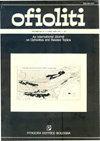片状岩脉复合体的构造:来自troodos蛇绿岩北缘及其与arakapas断裂带相邻的南缘的证据
IF 1.3
4区 地球科学
Q2 GEOLOGY
引用次数: 7
摘要
与侵入有关的片状堤防复合体的结构对于理解海底扩展是很重要的。在这里,我们提供了先前描述的沿着Troodos地块北缘的~东西向横走向剖面的数据。为了进行比较,我们还提供了Troodos地块南缘~NS剖面的新信息,该剖面与推断的海洋转换断层Arakapas断裂带相邻。N-Troodos边缘剖面分为两个倾角方向相反的主段,分别对应于东部的Solea地堑和西部的Stravros地堑。高温热液蚀变岩墙在两个地堑的相对侵入年代学中出现较早,其次是辉长岩体和无处不在的灰色片状岩墙;斜花岗岩脉侵入较晚。化学分析表明,无论是在整个片状复合体中,还是在详细记录了横切关系的几个特定部分中,都有向boninite类型组成的趋势。相对陡倾的晚期博尼岩型岩脉被解释为上枕熔岩的供给源。在阿拉卡帕斯断裂带北侧,大型斜花岗岩体侵入时间较早,依次被灰色岩墙、小型辉长岩侵入和晚期孤立的棕色岩墙所横切。化学分析表明,早期灰色岩墙和后期棕色岩墙均由化学性质相似的岩浆喂养。高度衰竭的博纳岩型岩脉产于阿拉卡帕斯断裂带附近。相对后期的棕色岩脉在转换带附近呈现向~ E-W方向的摆动,反映了相对顺时针方向的~ 90°垂直轴旋转。早期灰色岩脉显示较少的垂直轴旋转,但在低角度轴上显示复杂的旋转。小型断层主要为正、左旋走滑型。考虑到其他因素,我们推断,在整个右滑、张拉转换断裂带内,断层剖面发生在左偏置扩展轴附近。此外,在推断的转换带向南延伸的海底(现位于晚白垩世莫尼-梅兰格)暴露并侵蚀了枯竭的地幔哈尔兹伯基岩,为在Arakapas转换附近或内部存在拉张背景提供了额外的证据。综合证据表明,Troodos片状岩脉复合体作为一个整体是在俯冲带上不稳定的不对称扩张下发育的,其中相对晚期的岩浆伸展可能起了重要作用。扩张的地壳被一个相对较宽的张拉转换断裂带向南(以现在的坐标表示),地幔岩石沿着这个断裂带局部暴露并在海底受到侵蚀。本文章由计算机程序翻译,如有差异,请以英文原文为准。
Construction of a sheeted dyke complex: evidence from the northern margin of the troodos ophiolite and its southern margin adjacent to the arakapas fault zone
The structure of a sheeted dyke complex in relation to intrusion is important for an understanding of sea-floor spreading. Here, we provide data for a previously undescribed ~ E-W cross-strike section along the northern margin of the Troodos massif. For comparison, we also provide new information for a ~NS section along the southern margin of the Troodos massif, adjacent to the Arakapas Fault Zone, an inferred oceanic transform fault. The N-Troodos margin section is divided into two main segments with opposing dip directions, corresponding to the Solea graben in the east and the Stravros graben in the west. High-temperature, hydrothermally altered dykes occur relatively early in a relative intrusive chronology of both grabens, followed by gabbroic bodies and ubiquitous grey sheeted dykes; plagiogranite dykes intruded at relatively later stages. Chemical analysis reveals a trend towards a boninite-type composition, both in the sheeted complex as a whole and in several specific sections for which crosscutting relations were documented in detail. The relatively steeply dipping, late-stage, boninitic-type dykes are interpreted as feeders to the Upper Pillow Lavas. To the N of the Arakapas Fault Zone, large plagiogranite bodies intruded relatively early and were in turn transected by grey dykes, small gabbroic intrusions and late-stage isolated brown dykes. Chemical analyses show that both early-stage grey dykes and the later-stage brown dykes were fed by chemically similar magma. Highly depleted boninite-type dykes occur close to the Arakapas Fault Zone. The relatively late-stage brown dykes show a swing in orientation towards ~ E-W near the transform zone, reflecting an inferred up to ~ 90° relatively clockwise, vertical-axis rotation. The earlier-stage grey dykes are indicative of lesser amounts of vertical-axis rotation but show complex rotations about low-angle axes. Small-scale faults are mainly of normal and left-lateral strike-slip type. Taking alternatives into account, we infer that the faulting in the dyke section took place near a left-offset spreading axis within an overall right-slipping, transtensional transform fault zone. In addition, depleted mantle harzburgites were exposed and eroded on the seafloor within an inferred southward extension of the transform zone (now within the Late Cretaceous Moni Melange), proving additional evidence of a transtensional setting near or within the Arakapas transform. The combined evidence suggests that the Troodos sheeted dyke complex as a whole developed in response to unstable, asymmetrical spreading above a subduction zone in which relatively late-stage amagmatic extension is likely to have played an important role. The spreading crust was bounded to the south (in present coordinates) by a relatively broad transtensional transform fault zone, along which mantle rocks were locally exposed and eroded on the seafloor.
求助全文
通过发布文献求助,成功后即可免费获取论文全文。
去求助
来源期刊

Ofioliti
地学-地质学
CiteScore
2.40
自引率
7.70%
发文量
1
期刊介绍:
Since 1976, Ofioliti provides an international forum for original contributions and reviews in the field of the geodynamics, petrology, geochemistry, biostratigraphy, stratigraphy, tectonics and paleogeography applied to ophiolitic terrains and modern oceanic lithosphere, including their sedimentary cover. Studies of topics such as geodynamics of the mantle, the evolution of orogens including ophiolites and paleoceanography are also welcome
 求助内容:
求助内容: 应助结果提醒方式:
应助结果提醒方式:


